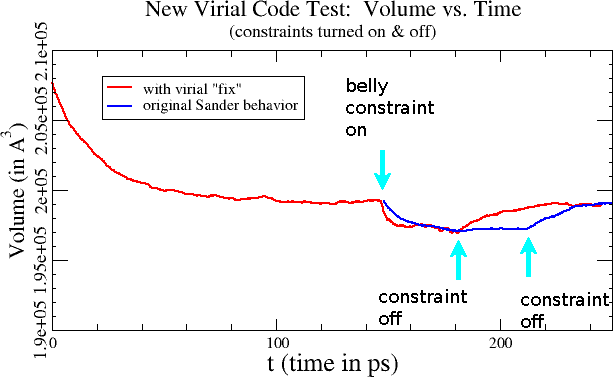Date: Thu, 10 Mar 2011 18:51:55 -0800
I ran some additional tests (see below).
You can skip the details.
The conclusion I've reached is that: I'm not sure that I've done a
very good job so far diagnosing what's wrong with Amber's pressure
regulation. Ill stand by the statement that there is definitely
something strange about the way Amber regulates the pressure when a
large number of constrained atoms are present. Surprisingly, pressure
equilibration in Amber is very different in the presence
belly-constrained atoms, than in the presence of harmonic-restrained
atoms, and I don't really trust either of them (or my own code to fix
them).
Perhaps the only useful thing I have done is to raise the issue.
Again, I'm not really using Amber these days. In case someone else
wants to pick up where I left off, I'm happy to help. I'll need some
help interpreting the Amber source code if you want me to continue.
Alternately, I can also send my amber input files and modified source
code (too big to post here).
Thanks for hearing my suggestions.
On Wed, Mar 9, 2011 at 8:54 AM, David A Case <case.biomaps.rutgers.edu> wrote:
>> What kind of "constraints" are you using? Do you understand what is going on,
>> e.g. why there is a bubble only on one side of the central slab?
>> This sounds almost like a two-line change to the code -- have you considered
>> trying it out?
On Wed, Mar 9, Andrew Jewett wrote:
> Sure.
> But I strongly suspect that changing this code alone won't prevent the
> bubble problem. (...But I'll test this and get back to you today.)
For the record, I checked this yesterday (details below), and the
results suggest that I don't really understand how AMBER presently
calculates the virial.
I've been trying to deduce how the virial is calculated from AMBER's
behavior. I can't find the Amber code which presently calculates the
virial. This makes it hard for me to fix it. Consequently, be
careful using the code I posted in appendix A of in the
"virial_fixed_atoms.pdf" I posted on Sunday. It might make things
worse. (For what it's worth, I do think that all of the discussions
and and equations I posted there are otherwise correct.)
What is strange is that the expansion behavior I reported (causing the
bubble) apparently only occurs when using harmonic restraints. (It
also only seems to happen when turning off the charge of some of the
restrained water.) When I use belly constraints (or leave the charge
alone), the bubble goes away, and the free liquid is actually
compressed. (And oddly, I see the same behavior whether or not I
attempt to correct the virial using the code from appendix A. I
haven't tried using this virial-correction code with harmonic
restraints yet.)
---Test 1 Details:---
I created a large box of water (47x47x90 A^3) with 6550 ordinary TIP3P
water molecules, and let it equilibrate under NPT conditions (at
T=300K, P=1bar). At t~=145 ps, I use belly to immobilize all the
water in a 60Angstrom thick slab (5<z<65). At the same time, to
create strong repulsion in the core, I neutralized the charge for all
the water molecules at the center of this slab (25<z<45, in
angstroms).
I use the code I posted in yesterday's post to prevent the belly atoms
from being rescaled during pressure equilibration.
(I'm happy to send my input files, code and binaries to anybody who
asks for them.)
Results:
The system is allowed to continue at P=1bar pressure for a short time,
and it compresses in size by about 1%.
I tried this without modifying the virial (blue curve). In a separate
run, I use the virial-correcting code from appendix A (red curve). In
both cases, the water compresses by about 1%. (This compression is
reversible: When the constraints are released, and the charge is
restored, the liquid expands to its original density.) This is
disturbing because I was not expecting the water density to change at
all. For reference, when harmonic restraints are used, the system
quickly expands to a huge size, creating a large bubble in the free
water.
---Test3: No restraints (core charges remain off)---
When I remove all the constraints, but leave the water in the core
layer neutral, the neutralize water layer expands to a large size, but
I have not seen a bubble form anywhere yet. (I've only let it expand
for 167 ps. I should probably run it for longer.)
_______________________________________________
AMBER mailing list
AMBER.ambermd.org
http://lists.ambermd.org/mailman/listinfo/amber

(image/png attachment: volume_vs_time_new.png)
